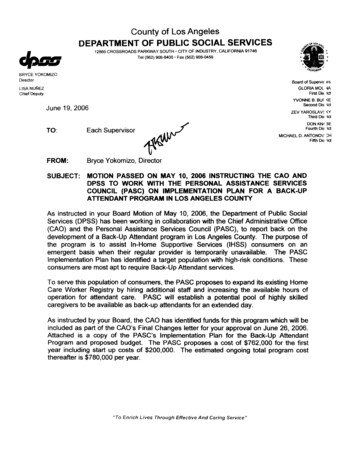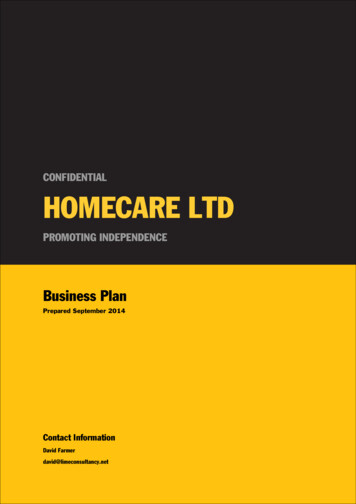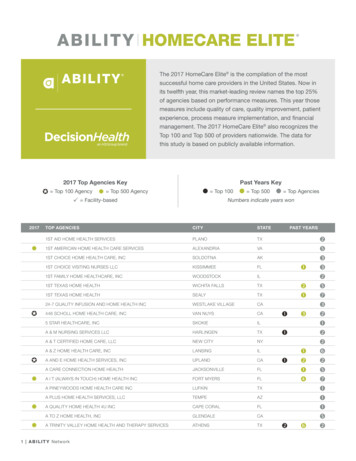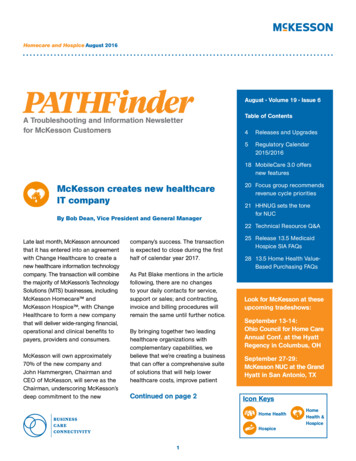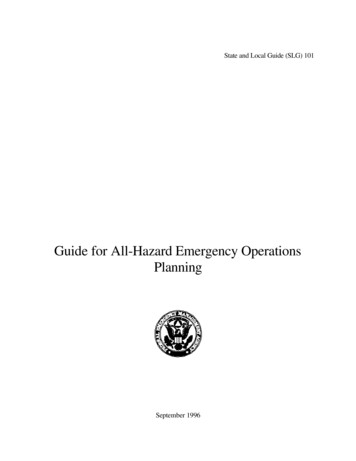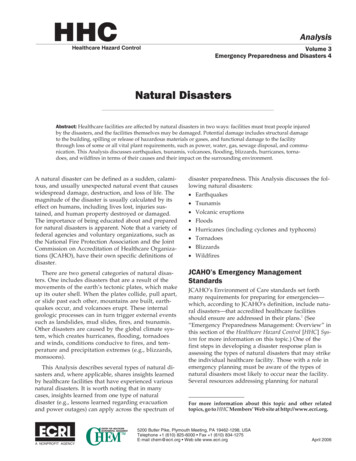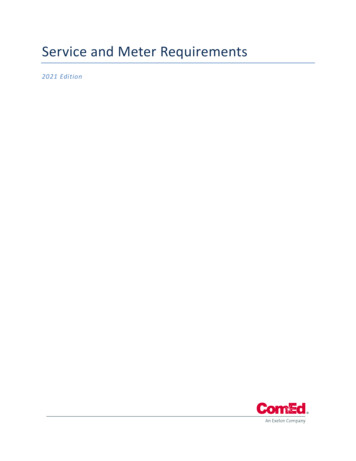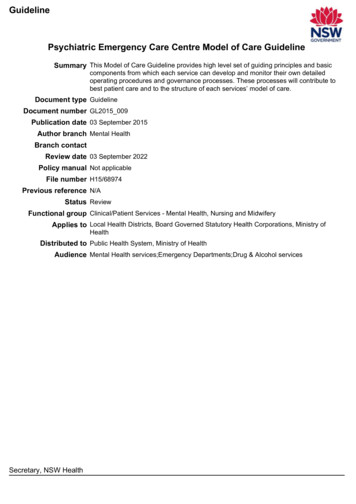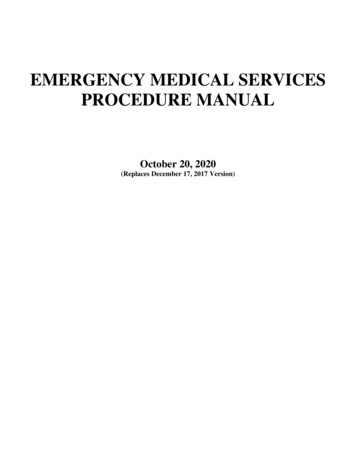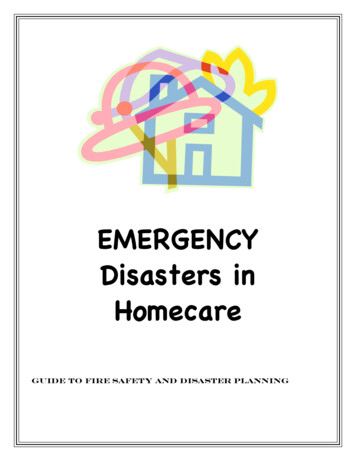
Transcription
EMERGENCYDisasters inHomecareGuide to fire safety and disaster planning
This Material was developed by theSEIU Education and Support Fund (ESF)For more information about this or other manuals, please contact:SEIU Health and Safety Education & Support Fund at 202-730-7385This material was produced under grant number SH-20861-SHOfrom the Occupational Safety and Health Administration, U.S.Department of Labor. It does not necessarily reflect the views orpolicies of the U.S. Department of Labor, nor does the mention oftrade names, commercial products, or organization implyendorsement by the U.S. Government. SEIU Education and Support Fund 2011
SECTION ONEFIRE SAFETYFIRE! FIRE! FIRE!Purpose of Section 1To discuss the benefits of fire safety in homecare.Objectives of Section 1By the end of this section you will be able to: name some of the fire hazards that homecare workers face identify through risk mapping potential fire hazards around theclient’s home. Ways to improve fire safety in the client’s homeCan there be multiple fire-hazards in1the client’s home?TASKWhat is your group’s response to a co-worker who makes thisstatement?“My client has Alzheimer’s and is a smoker. She hasso many newspapers all around the apartment, andhates getting rid of any paper. I also recently noticeda lot of devices plugged into one electrical extensioncord in every room. I think I am in danger!”Question: What are some important things your co-worker shouldknow?Use the Factsheets A -E to help you complete this Task. 2011 SEIU E&SF3
FACTSHEETSECTION ONEThis is FireAEvery day Americans experience the horror of fire. But most peopledon't understand fire. Only when we know the true nature of fire can weprepare ourselves and our families. Each year more than 4,000Americans die and approximately 25,000 are injured in fires, many ofwhich could be prevented.The United States Fire Administration (USFA), a division of the FederalEmergency Management Agency (FEMA), believes that fire deaths can bereduced by teaching people the basic facts about fire. Below are somesimple facts that explain the particular characteristics of fire.Fire is FAST! There is little time! In less than 30 seconds a small flame can get completely out ofcontrol and turn into a major fire. It only takes minutes for thickblack smoke to fill a house. In minutes, a house can be engulfed inflames. Most fires occur in the home when people are asleep. If youwake up to a fire, you won't have time to grab valuables because firespreads too quickly and the smoke is too thick. There is only time toescape.Fire is HOT! Heat is more threatening than flames. A fire's heat alone can kill. Room temperatures in a fire can be 100degrees at floor level and rise to 600 degrees at eye level. Inhalingthis super hot air will scorch your lungs. This heat can melt clothes toyour skin. In five minutes a room can get so hot that everything in itignites at once: this is called flashover.Fire is DARK! Fire isn't bright, it's pitch black.Fire starts bright, but quickly produces black smoke and completedarkness. If you wake up to a fire you may be blinded, disoriented andunable to find your way around the home you've lived in for years.4
SECTION ONE(Continued)FACTSHEETThis is FireAFire is DEADLY! Smoke and toxic gases kill more people than flamesdo. Fire uses up the oxygen you need and produces smoke andpoisonous gases that kill. Breathing even small amounts of smokeand toxic gases can make you drowsy, disoriented and short ofbreath. The odorless, colorless fumes can lull you into a deep sleepbefore the flames reach your door. You may not wake up in time toescape.5
SECTION ONEFACTSHEETFires in the pastBQuick StatsThe Overall Fire Picture – 2007(NFPA) There were 3,430 civilians that lost their lives as the result of fire. There were 17,675 civilian injuries that occurred as the result of fire. There were 118 firefighters killed while on duty. Fire killed more Americans than all natural disasters combined. 84 percent of all civilian fire deaths occurred in residences. There were an estimated 1.6 million fires in 2007. Direct property loss due to fires was estimated at 9.8 billion. An estimated 32,500 intentionally set structure fires resulted in 320 civilian deaths. Intentionally set structure fires resulted in an estimated 733 million in property damage.Structure Cooking Fires Cooking is the leading cause of fires and fire injuries in structures. Deaths andproperty losses due to cooking, however, are among the lowest. In 2002, cooking fires and injuries peaked at 6 p.m.—the dinner hour. There was aslight decrease in cooking fires in the summer when more outdoor barbecuing andfamily vacationing occur. The leading type of material ignited in cooking fires is food, especially fats, oils, andgrease. Cooking left unattended is the leading factor contributing to cooking fires. A smoke alarm was present and alerted the occupants in 45% of cooking fires.6
SECTION ONEFACTSHEETCommon Types of Fire er7
SECTION ONEFACTSHEETWorkplace Fires (Client’s Home)DWho’s at risk Client Family WorkersWh at S aves Lives Fire safety plan Smoke detectorsFire alarms A whistle Kitchen fire extinguisher Cell Phone Unblock walkways/ hallways Flash lights with extrabatteriesFire Safety TipsIn the event of a fire, remember time is the biggest enemy and everysecond counts!Escape first, then call for help. Develop a home fire escape plan anddesignate a meeting place outside. Make sure everyone in the familyknows two ways to escape from every room. Practice feeling your wayout with your eyes closed. Never stand up in a fire, always crawl lowunder the smoke and try to keep your mouth covered. Never return to aburning building for any reason; it may cost you your life.Finally, having a working smoke alarm dramatically increases your chancesof surviving a fire. And remember to practice a home escape plan frequentlywith your family.8
SECTION ONEFACTSHEETKeep Your Client’s Home SafeEThe National Fire Protection Association reports 85% of fire deaths occur in the home,making fire prevention a top priority in every home.Here is a list of some of the less obvious tips for fire prevention, based on the mostcommon causes of fires:Cooking equipmentCooking is the number one cause of home fires.Keep appliances clean, and wipe surfaces after spills. Clean stove surfaces and ovensregularly.Wear tight-fitting sleeves, or roll them up when cookingKeep flammable objects, including pot holders, dish towels and curtains, at least threefeet away from the stove.Assure microwaves have enough room to breathe, that all the vents are cleared ofobstructions.If there is a microwave fire, keep the door closed and unplug the microwave. Make sureto have the microwave oven serviced before you use it again.A grease fire occurs when oil or greasy foods are heated and ignite. The simplest wayto fight a grease fire is to carefully slide a lid over the pan. Turn off the burner, don'tmove the pan, and keep the lid on until the pan cools completely. Baking Soda may alsobe used to suffocate the fire. NEVER PUT WATER ON A GREASE FIRE. Water causes thegrease to splatter and the fire to spread. Also, NEVER attempt to take a grease fireoutdoors. It will be too hot to carry and you will drop it, causing a major house fire.Heating Equipment is the leading cause of home fires during the winter months ofDecember, January and February, and is the second-leading cause of home fires yearround.9
SECTION ONEContinuedFACTSHEETKeep Your Client’s Home SafeEElectrical Distribution EquipmentWiring, outlets, switches, circuit breakers and other electrical devices are the thirdleading cause of home fires and the second leading cause of fire deathsReplace or repair loose or frayed cords on all electrical devices. If outlets or switches feel warm, shut off the circuit and have them checked byan electrician. Try to avoid extension cords. If you feel an extension cord is necessary, makesure that it is not frayed or worn. Do not run it under carpet or arounddoorways. Never overload a socket. The use of "octopus" outlets or "power bar", outletextensions that accommodate several plugs, is strongly discouraged. Try to limitone high-wattage appliance into each individual outlet at a time. If a circuit breaker trips or a fuse blows frequently, cut down on the number ofappliances on that line. In many older homes, the capacity of the wiring systemhas not kept pace with today's modern appliances and can overload electricalsystems. Some overload signals include: dimming lights when an appliance goeson, fuses blowing frequently or shrinking TV picture. Assure there's plenty of air space around home entertainment units such as theTV and stereo to avoid overheating.SmokingSmoking is the leading cause of home fire deaths in the United States.More to think aboutGet rid of stored newspaper or other unnecessary materials. Newspapers storedin a damp, warm place may ignite spontaneously. Install smoke detectors on every level of your home and outside of sleepingareas. Mount a fire extinguisher in the kitchen, garage and workshop. Agree in advance on an escape plan. There should be at least two exits in everyroom.Note: Half of all home fire deaths occur at night, so fire hazard checks and specialattention to fire prevention should occur before going to bed.10
SECTION ONETASKFIRE SAFETY2 Risk Mapping Fire HazardsIn your groups, draw the floor plan of your client’s home. Identifywhere all possible fire hazards could exist. Use markers and theflip chart paper to draw and label each area on your map. Labelall of the places where a:1. Fire hazard could exist (place red dot)2. Smoke detector should go (place green dot)3. Fire extinguisher should go (place a blue dot)Think about these questions below and be prepared answer inyour group’s report back:(Use your experience and all factsheets F-J)1. On your map, where did possible fire hazards exist?2. Would you place different types of fire extinguishers in differentareas of the home? Why or why not?3. Is it important to check smoke detectors? why or why not?4. In a fire emergency, how would you determine if you shouldstay or leave the home? 2011 SEIU E&SF111
SECTION ONEFACTSHEETKnow your Class!FClass AExtinguishers will put out fires in ordinarycombustibles, such as wood and paper. The numerical rating for this class of fireextinguisher refers to the amount of water the fire extinguisher holds and theamount of fire it will extinguish.Class BExtinguishers should be used on fires involvingflammable liquids, such as grease, gasoline, oil, etc. The numerical rating for thisclass of fire extinguisher states the approximate number of square feet of aflammable liquid fire that a non-expert person can expect to extinguish.Class CExtinguishers are suitable for use on electricallyenergized fires. This class of fire extinguishers does not have a numerical rating.The presence of the letter “C” indicates that the extinguishing agent is nonconductive.Multi-Class RatingsMany extinguishers available today can be used on different types of fires and willbe labeled with more than one designator, e.g. A-B, B-C, or A-B-C. Make sure thatif you have a multi-purpose extinguisher it is properly labeled.To operate a fire extinguisher, remember the word PASS: Pull the pin. Hold the extinguisher with the nozzle pointing away fromyou, and release the locking mechanism. Aim low. Point the extinguisher at the base of the fire. Squeeze the lever slowly and evenly. Sweep the nozzle from side-to-side.12
SECTION ONEFACTSHEETLocation, location, location!GHaving a fire extinguisher is one thing, having it handy in case ofan emergency, is another.It is recommended to have at least one fire extinguisher on eachfloor of your home. Also, keep them in plain sight and no morethan five feet above the floor. Do not put them in closets becausethat will cost you valuable time when you are reaching for it. Andeven though a fire extinguisher may not match your décor, do notput it behind curtains or drapes.The most important places to have a fire extinguisher are in areasthat are more susceptible to fire. These areas are the kitchen andthe garage.Kitchen: According to U.S. Fire Administration statistics, thekitchen is the place where fires most often start. If you have a fireextinguisher in the kitchen, most grease fires can be contained. Donot put the fire extinguisher near the stove as it will be out of yourreach if the fire is on the stovetop. You should not have to riskburns just to reach your extinguisher. Therefore, the best place toput the fire extinguisher is by the door of the kitchen so you haveeasy access to it.Garage: It is a good idea to keep a fire extinguisher here becausein most homes, this is the place we use as storage. Often, leftoverpaints, solvents, and building materials will be piled up without asecond thought. Again, the best location to mount the fireextinguisher is by the door.13
SECTION ONEFACTSHEETSmoke AlarmsHIn the event of a fire, properly installed and maintained smoke alarms will provide anearly warning signal to your household. This alarm could save your own life and thoseof your loved ones by providing the chance to escape.THE IMPACT OF SMOKE ALARMSIn the 1960's, the average U. S. citizen had never heard of a smoke alarm.By 1995, an estimated 93 percent of all American homes - single - andmulti- family, apartments, nursing homes, dormitories, etc. - were equippedwith alarms. By the mid 1980's, smoke alarm laws, requiring that alarms beplaced in all new and existing residences - existed in 38 states andthousands of municipalities nationwide. And smoke alarm provisions havebeen adopted by all of the model building code organizations.What if the alarm goes off while I'm cooking?Then it's doing its job. Do not disable your smoke alarm if it alarms due to cooking orother non-fire causes. You may not remember to put the batteries back in the alarmafter cooking. Instead, clear the air by waving a towel near the alarm, leaving thebatteries in place. The alarm may have to be moved to a new location.Placing your smoke detectorFor minimum protection, install a smoke detector outside of each bedroom orsleeping area in your home. For extra safety, install smoke alarms both inside andoutside the sleeping area.Keep your bedroom doors closed while you are asleep. Better, install detectorson every level of your home.Keep your smoke detectors properly maintained. Test them once a weekto ensure that the detectors are working properly.Every Spring and Fall when you change your clocks, remember tochange your smoke alarm batteries. Use only the type of batteriesrecommended on the detector.Always follow the manufacturer's installationinstructions.14
SECTION ONEFACTSHEETCarbon MonoxideIWhat is carbon monoxide?Carbon Monoxide (CO) is a colorless, odorless, tasteless, non-irritating gas produced wheneverany carbon-based fuel such as wood, charcoal, gasoline, oil, kerosene, propane, or natural gas isnot burned properly (incomplete combustion). CO exposure is responsible for more fatalunintentional poisonings in the United States than any other agent, with the highest incidenceoccurring during the cold-weather months.Where does carbon monoxide come from?Potential sources of CO include: unvented kerosene, propane, and gas space heaters; leakingchimneys and furnaces; back-drafting or spillage from furnaces, gas water heaters, wood stoves,and fireplaces; gas ovens and ranges; and automobile exhaust fumes. Tobacco smoke, includingsecond hand smoke, is also a source of CO exposure in homes with smokers.How can carbon monoxide poisoning affect my health?Exposure to CO can be deadly. The Consumer Product Safety Commission reports thatapproximately 200 people per year are killed by accidental CO poisoning with an additional5,000 people injured.CO enters the bloodstream and reduces the delivery of oxygen to the body’s organs and tissues.Symptoms vary widely based on exposure level, duration, and the general health and age of anindividual. Mild exposure symptoms may mimic the flu and include: mild headache andweakness, dizziness, sleepiness, shortness of breath, tightness in the chest, nausea and/orvomiting. High or prolonged exposures to CO can cause: confusion, loss of muscle control,blurred vision, extreme headache and weakness, fainting, convulsions, and death.What should you do if carbon monoxide poisoning is suspected?*Move the victim to fresh air immediately.*Open doors and windows to improve ventilation.*Turn off combustion appliances and leave the house.*Get to the Emergency Room of a local hospital and tell the physician you suspectCO poisoning. However, the victim should not drive if the symptoms are severe or persist onceoutside. Call for medical assistance.Protect yourself. Get a carbon monoxidedetector!!15
SECTION ONEFACTSHEETJStay in, or Get out (For High Rise Structures)If The Fire is in Your Apartment Get everyone out. Stay low asyou go out. Close but don't lockall doors in the apartment as youleave. Alert others on the floor byknocking on doors. Activate thefire alarm if there is one.Go down the nearestSTAIRWAY, holding the railing.Call the Fire Department from afloor BELOW THE FIRE orfrom a street fire alarm boxoutside.If the Fire is NOT in Your Apartment Stay inside rather than enteringsmoke-filled hallways, especiallyif the fire is on a floor belowyour apartment. Keep your door closed. Unless flames or smoke arecoming from below, open yourwindows a few inches at the topor bottom. Don't break thewindows; they may need to beclosed later.Call the Fire Department withyour apartment number and adescription of the conditions inyour apartment. Firefighters willbe directed to your location.If you feel you are in gravedanger, open a window and wavea bed sheet for firefighters to spotyou.NOT ALL HOMES ARE THE SAME SO BASIC FIRE PLANNING IS ESSENTIALGET OUT SAFELY! (All Other Structures) Everybody in the household mustunderstand and practice an escapeplan from every room.If possible, plan multiple exits (atleast 2) then practice from each exit.Rehearse escape plan both day andnight. Choose an outside meeting placeand take attendance (i.e. neighbor'shouse, a light post, mailbox, or stopsign)Plan how to get infants, smallchildren, and elderly or handicappedfamily members out quickly andsafely.16
SECTION ONEFIRE SAFETYSection 1Things to Remember:1. Fire injuries can be reduced byteaching people about fire safety.2. Some common types of fire hazardsinclude: Cooking, candles andsmoking.3. An Easy and effective wayto prevent fire injuries iswith a fire extinguisher anda smoke alarm.4. Planning and preparationsaves lives 2011 SEIU E&SFSummary117
"We may brave human laws,but we cannot resistnatural ones."-Jules Verne(20,000 leagues under the sea)18
SECTION TWODISASTER READINESSDisaster/EmergencyReadinessPurpose of Section 2To learn about the different types of emergency disasters homecare workersmay be exposed to.Objectives of Section 2By the end of this section you will be able to: Name some of the natural and man-made diasters that homecare workersface Solve real life “what should you do scenarios” (case studies)TASK1What Could we learn from others?Often times we hear of situations and wonder what we had done ifwe were there. This is our opportunity to critically think about howwe would react in emergency situations.Read the following case studies and answer the questions thatfollow using your group’s experience. 2011 SEIU E&SF119
SECTION TWODISATER READINESSMarge a homecare worker, was with her client one evening. Her clientsuffers from Alzheimer’s. Suddenly, the power goes out, several minuteslater Marge realizes that they’re in a blackout. She looks out the windowsand sees everything is dark. She panics and considers leaving theapartment with her client. It was clear the client was scared and did notwant to leave the apartment. Marge then searches around for flashlightsand finds some old candles. She lights them in every room. Marge tells herclient to stay near the candle in the bedroom while she finds out what’sgoing on.1. In your opinion, was done well?2. In your opinion, what would you do different?Our Groups Response is: 2011 SEIU E&SF20
SECTION TWODISASTER READINESSSharon is a homecare worker who works for a client who has Alzheimer’s and uses awheelchair. Her client lives on the 15th floor of a large complex building. While cookingher client’s food, she is called by the client to take her to the bathroom. While in thebathroom, Sharon starts smelling smoke and the smoke alarms go off. She searchesthe apartment and finds that the smoke is coming from kitchen. The food she wascooking is on fire. She panics, wondering if she should leave the apartment with herclient or stay. She quickly realizes the fire is still small enough to put out, so she grabsthe handle and puts the frying pan into the sink and runs the water. She opens thewindow to air out the room.1. In your opinion, was done well?2. In your opinion, what would you do different?Our Groups Response is: 2011 SEIU E&SF21
“Action springs not from thought,but from a readiness forresponsibility.”-Dietrich Bonhoeffer22
SECTION TWOTASK2DISASTER READINESSMajor DisastersIn a major disaster, it might be several daysbefore vital services are restored.Imagine that you have no electricity, no gas, no water and notelephone service. Imagine that all the businesses are closed and you arewithout any kind of emergency services. What will you do until helparrives?In your groups, pick 1 natural and 1 man-made disaster fromthe list on the next page. Discuss how you would prepare yourself and yourclient for that disaster. Be prepared to share your answers with the wholegroup.Use the Factsheets A-I to help you complete this Task, and answer thesequestions?1. What disasters did your group pick? why?2. Describe how you would prepare. 2011 SEIU E&SF123
Types ofDisastersNATURAL DISASTERSMAN-MADE DISASTERSEARTHQUAKESNUCLEAR & RADIOLOGICALACCIDENTSFLOOD & FLASH FLOODSHOME & BUILDING FIRESHURRICANESHAZARDOUS MATERIALSACCIDENTTORNADOESTERRORISMTHUNDERSTORMS & LIGHTNINGAVIATION ACCIDENTSSNOW, ICE, & WINTER STORMSSHIP/MARITIME ACCIDENTSHEATWAVE & DROUGHTTRAIN/RAILROAD ACCIDENTSLANDSLIDES & MUDFLOWSRIOTS/CIVIL UNRESTTSUNAMIS & OTHER TIDAL ACTIONBRIDGE COLLAPSESVOLCANOESDAM BREAKSWILDFIRESPOWER OUTAGES24
SECTION TWOFACTSHEETDisaster-VS-EmergencyAWHAT IS A DISASTER?A disaster (from Greek meaning, "bad star") is a natural orman-made event that negatively affects life, property,livelihood or industry often resulting in permanent changesto human societies, ecosystems and environment.WHAT IS AN EMERGENCY?An emergency is a sudden unforeseen crisis (usuallyinvolving danger) that requires immediate action. It is asituation that poses an immediate threat to human life orserious damage to property.25
SECTION TWOFACTSHEETBlack Out/Power OutagesBWhat Do I Do During A Blackout? Turn off or disconnect any appliances, equipment(like air conditioners) or electronics you were using when the power went out. Whenpower comes back on, it may come back with momentary "surges" or "spikes" that candamage equipment such as computers and motors in appliances like the air conditioner,refrigerator, washer, or furnace. Only use a flashlight for emergency lighting. Never use candles! Do not run a generator inside a home or garage. If you use a generator, connect the equipment you want to power directly to theoutlets on the generator. Do not connect a generator to a home's electricalsystem.Leave one light turned on so you'll know when your power returns. Leave the doors of your refrigerator and freezer closed to keep your food asfresh as possible. If you must eat food that was refrigerated or frozen, check itcarefully for signs of spoilage. If you have a telephone instrument or system at home or at work that requireselectricity to work (such as a cordless phone or answering machine), plan foralternate communication, including having a standard telephone handset, cellulartelephone, radio, or pager. Use the phone for emergencies only. Listening to a portable radio can providethe latest information. Do not call 9-1-1 for information -- only call to report a lifethreatening emergency.Specific Information for People With Disabilities If you use a battery-operatedwheelchair, life-support system, or other power-dependent equipment, call yourpower company before rolling blackouts happen. Many utility companies keep a listand map of the locations of power-dependent customers in case of an emergency.Ask them what alternatives are available in your area. Contact the customer servicedepartment of your local utility company(ies) to learn if this service is available in yourcommunity26
SECTION TWOFACTSHEETTerrorismCDevastating acts, such as the terrorist attacks on the World Trade Center and thePentagon, have left many concerned about the possibility of future incidents in the UnitedStates and their potential impact. They have raised uncertainty about what might happennext, increasing stress levels. Nevertheless, there are things you can do to prepare for theunexpected and reduce the stress that you may feel now and later should anotheremergency arise. Taking preparatory action can reassure you and your client that you canexert a measure of control even in the face of such events.If Disaster Strikes Remain calm and be patient.Follow the advice of local emergency officials.Listen to your radio or television for news and instructions.If the disaster occurs near you, check for injuries. Give first aid and get help forseriously injured people.If the disaster occurs near your home while you are there, check for damage using aflashlight. Do not light matches or candles or turn on electrical switches. Check forfires, fire hazards and other household hazards. Sniff for gas leaks, starting at thewater heater. If you smell gas or suspect a leak, turn off the main gas valve, openwindows, and get everyone outside quickly.Shut off any other damaged utilities.Confine or secure your pets.Call your family contact—do not use the telephone again unless it is a lifethreatening emergency.Check on your neighbors, especially those who are elderly or disabled.What Shelter-in-Place Means: One of the instructions you may be given in an emergencywhere hazardous materials may have been released into the atmosphere is to shelter-inplace. This is a precaution aimed to keep you safe while remaining indoors. (This is notthe same thing as going to a shelter in case of a storm.) Shelter-in-place means selectinga small, interior room, with no or few windows, and taking refuge there. It does not meansealing off your entire home or office building. If you are told to shelter-in-place, follow theinstructions at the red cross website27
SECTION TWOFACTSHEETHome/Building firesDMake Your Home Fire Safe Smoke alarms save lives. Install a smoke alarm outside each sleeping area and oneach additional level of your home.If people sleep with doors closed, install smoke alarms inside sleeping areas, too.Use the test button to check each smoke alarm once a month. When necessary,replace batteries immediately. Replace all batteries at least once a year.Vacuum away cobwebs and dust from your smoke alarms monthly.Smoke alarms become less sensitive over time. Replace your smoke alarms everyten years.Consider having one or more working fire extinguishers in your home. Get trainingfrom the fire department in how to use them.Consider installing an automatic fire sprinkler system in your home.Plan Your Escape Routes Determine at least two ways to escape from every room of your home.Consider escape ladders for sleeping areas on the second or third floor. Learn howto use them and store them near the window.Select a location outside your home where everyone would meet after escaping.Practice your escape plan at least twice a year. Escape Safely Once you are out, stay out! Call the fire department from a neighbor's home.If you see smoke or fire in your first escape route, use your second way out. If youmust exit through smoke, crawl low under the smoke to your exit.If you are escaping through a closed door, feel the door before opening it. If it iswarm, use your second way out.But, If smoke, heat, or flames block your exit routes, stay in the room with the door closed.Signal for help using a bright-colored cloth at the window. If there is a telephone in theroom, call the fire department and tell them where you are.28
SECTION TWOFACTSHEETHeatwavesEKnow What These Terms Mean.Heat wave: Prolonged period of excessive heat and humidity. The National WeatherService steps up its procedures to alert the public during these periods of excessiveheat and humidity. Heat index: A number in degrees Fahrenheit (F) that tells how hot it really feels whenrelative humidity is added to the actual air temperature. Exposure to full sunshine canincrease the heat index by 15 degrees F. Heat cramps: Heat cramps are muscular pains and spasms due to heavy exertion.Although heat cramps are the least severe, they are an early signal that the body ishaving trouble with the heat. Heat exhaustion: Heat exhaustion typically occurs when people exercise heavily orwork in a hot, humid place where body fluids are lost through heavy sweating. Bloodflow to the skin increases, causing blood flow to decrease to the vital organs. Thisresults in a form of mild shock. If not treated, the victim may suffer heat stroke. Heat stroke: Heat stroke is life-threatening. The victim's temperature control system,which produces sweating to cool the body, stops working. The body temperature canrise so high that brain damage and death may result if the body is not cooled quickly. Sunstroke: Another term for heat stroke.
If there is a microwave fire, keep the door closed and unplug the microwave. Make sure to have the microwave oven serviced before you use it again. A grease fire occurs when oil or greasy foods are heated and ignite. The simplest way to fight a grease fire is to caref
